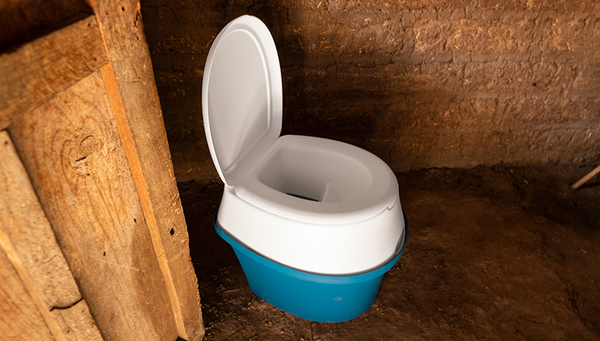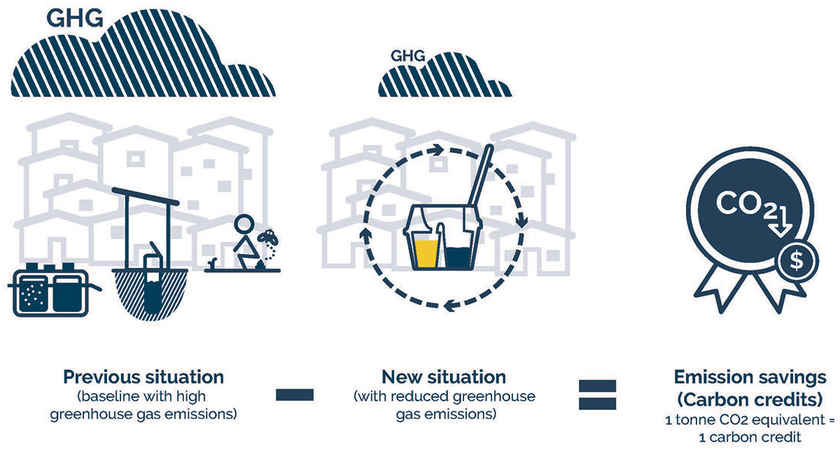News Detail
Generating carbon credits with container-based sanitation
May 16, 2023 |
Container-based sanitation (CBS) is a sanitation solution where human excreta is collected in sealable, removable containers that are frequently removed by service providers, who safely treat the excreta for end use or disposal. CBS provides safe sanitation if the entire service chain is adequately managed. Because the excreta is only stored briefly in the containers before being processed into reusable products, CBS systems can avoid the greenhouse gas (GHG) emissions that are associated with other common onsite sanitation technologies. This is due to the short storage times under aerobic conditions, for example 1 - 2 weeks, compared to the long-term storage under mostly anaerobic conditions in common onsite sanitation systems.
Carbon offset schemes allow companies and individuals to compensate for their GHG emissions by investing in projects that reduce or remove GHG elsewhere. The reduction or removal of GHG can be sold on the voluntary carbon market in the form of carbon credits. One tonne of avoided CO2 emissions equals one carbon credit. Reporting such GHG savings on the carbon market could generate revenue from the sale of the carbon credits. What was lacking was a methodology that permits CBS businesses to systematically calculate their GHG emission savings.
Developing a draft methodology
Sandec’s Management of Excreta, Wastewater and Sludge (MEWS) research group and partner Mosan, a CBS enterprise in Guatemala, used a template from the Verified Carbon Standard (VCS), an established carbon standard for this market, as the basis to develop a draft methodology to quantify the GHG mitigation potential of CBS solutions. This quantification is a necessary step in order to register for carbon credits on the voluntary carbon market. The draft methodology includes all of the transformation processes (e.g. composting, black soldier fly treatment, or pyrolysis) currently applied by the eight main CBS companies (Mosan, Clean Team, Loowatt, Sanergy, Sanitation First, Sanivation, SOIL, and Sanima), as well as emissions from transportation because it has to be globally applicable in the CBS sector.
Completing a carbon crediting methodology from initiation to certification takes time, generally one to two years. Presently, the Container Based Sanitation Alliance (CBSA) is further developing the draft methodology, and is working in collaboration with carbon finance consultancy companies and investors to assess the feasibility of developing a complete certified methodology.
Read a more in-depth article about this MEWS project in the annual magazine of the Eawag-Department of Water, Sanitation and Solid Waste (Sandec) at: www.sandec.ch.
Original publication
Andriessen, N., ‘Quantifying Greenhouse Gas Savings from Container-based Sanitation’, Sandec News, 23 (2022), Seiten 22-23.
Links and Documents
- Johnson, J. et al., ‘Whole-system Analysis Reveals High Greenhouse-gas Emissions from Citywide Sanitation in Kampala, Uganda’, Communications Earth & Environment, 3/1 (2022) 80.
- Seitz, D., ‘A Methodological Approach to the Assessment of the Greenhouse Gas Mitigation Potential of Container-Based Sanitation Systems’, MSc Thesis (ETH Zürich, 2021).
- Trondsen, L. et al., ‘Calculating the Climate Change Mitigation Potential of Container-based Sanitation Systems’, UNC Poster Presentation (Container Based Sanitation Alliance, 2019). (pdf, in Englisch)
Cooperations
Mosan, Guatemala


